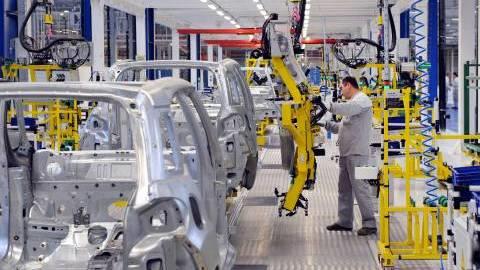French Industrial Output Rebounds
(MENAFN- ING) French industrial production rebounded slightly more than expected in April, but without making up for the fall in March. All the indicators point to a weakening in industrial production

Slight rebound after the poor figures for consumption of goods , the industrial production data for April was slightly better than expected, a good thing for economic growth in the second quarter. Industrial production rose by 0.8% over one month in April, following a fall of 1.1% in March. The rise was visible in almost all sectors, with a particularly strong rebound in coking and refining, where strike action eased in April compared with March. The manufacture of transport equipment was up by 2% over one month, while that of capital goods was up by 1.4%. Conversely, production continued to fall in the agri-food industries (-0.3% after -0.4% in March).
The rebound in manufacturing output in April was nevertheless unable to offset the fall in March, and production was still below its February level. What's more, French industrial output is still 5% below its pre-pandemic level (February 2020), while at the same time, GDP is 1.3% above its pre-pandemic level. The recovery of the last three years has therefore not been very favourable to the industrial sector, which has been held back more than the rest of the French economy by disruptions to supply chains, then by the energy crisis and finally by the slowdown in the global economy and the strikes against the pension reform. INSEE also reports that output in the most energy-intensive industrial sectors is down sharply, by 22.7% year-on-year in the steel industry, by 24.7% in paper and cardboard manufacturing and by 15.5% in chemicals manufacturing.
The rebound in industrial production in April does not raise hopes of an acceleration in economic growth in the second quarter. Nonetheless, the fact that the start to the quarter was less poor than expected for industry means that GDP growth will probably remain in positive territory in the short term. However, this rebound will have to be confirmed by the figures for May.
A gloomy outlook for industry Unfortunately, the outlook for industry remains bleak. Quite simply, all the indicators currently point to a deterioration in industrial production over the coming months. Business sentiment in the sector has been falling sharply since February and continued to do so in May. Business leaders are taking a more negative view of both the current situation and the outlook for the coming months. In particular, the assessment of order books is in free fall and has reached its lowest level since March 2021. At the same time, inventories of finished products are high. This means that production will have to fall over the coming months, as companies see no new orders coming in and have to use up their inventory.
The PMI indices for the manufacturing sector have been in contraction territory (below 50) since January and are not picking up. According to the European Commission's quarterly surveys, demand is now a factor limiting production for 30% of companies, a percentage that has been rising steadily over the past year (although historically still fairly low). The transport equipment sub-sector should continue to grow. Firstly, because it is still 13.5% below its pre-pandemic level, it has greater growth potential over the coming months. Secondly, the indicators for this sub-sector are looking better, with order books fuller than in the rest of the industry. The question is therefore whether the return to normal in the transport equipment sub-sector will be enough to offset the weakness in the rest of the industry. The difficult outlook for the industrial sector, the significant weakness in household consumption, the context of rising interest rates which is increasingly being felt and the first signs of a weakening labour market suggest that growth will remain very moderate over the next few quarters. At this stage, we are expecting GDP growth of 0.6% in 2023 and 0.7% in 2024, with the risks tilted to the downside, as the risk of recession cannot be ruled out. these forecasts are much weaker than the - very optimistic - government forecasts, which are counting on 1% and 1.6% growth for 2023 and 2024.
Share
Author

More on France

france: consumption plunges while inflation moderates french business climate decline shows warning signals ahead
MENAFN04062023000222011065ID1106383244
*Content Disclaimer:
This publication has been prepared by ING solely for information purposes irrespective of a particular user's means, financial situation or investment objectives. The information does not constitute investment recommendation, and nor is it investment, legal or tax advice or an offer or solicitation to purchase or sell any financial instrument. Read more here: https://think.ing.com/about/disclaimer/

Legal Disclaimer:
MENAFN provides the information “as is” without warranty of any kind. We do not accept any responsibility or liability for the accuracy, content, images, videos, licenses, completeness, legality, or reliability of the information contained in this article. If you have any complaints or copyright issues related to this article, kindly contact the provider above.